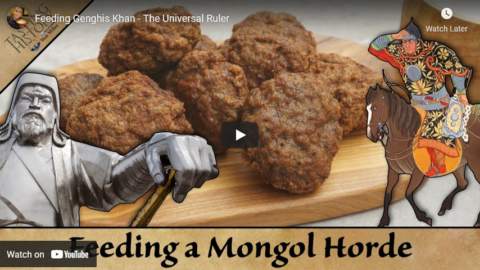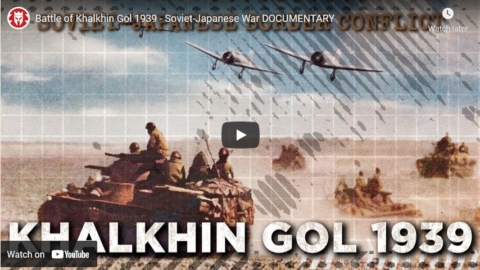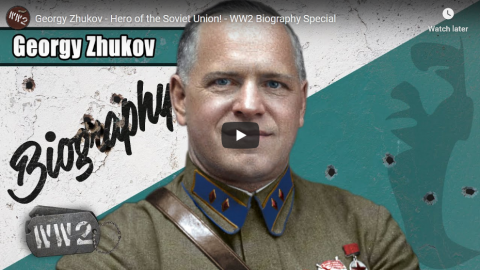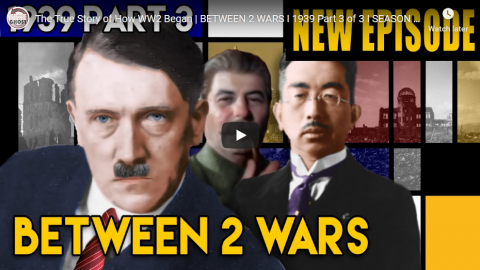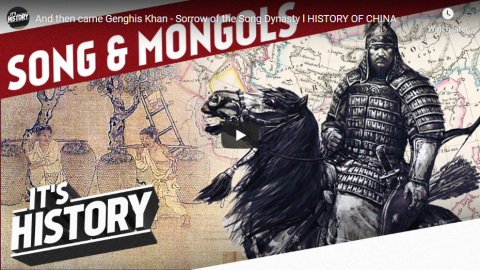Real Time History
Published Dec 1, 2023December 7, 1941: The Japanese attack on Pearl Harbor shocked the world and brought the US into the Second World War. But why did the Japanese resort to such an attack against a powerful rival and what did it have to do with the Japanese war in China?
(more…)
April 22, 2024
Did Japan Attack Pearl Harbor Because Of China?
October 14, 2023
QotD: Horses and sheep on the Eurasian Steppe
Now just because this subsistence system is built around the horse doesn’t mean it is entirely made up by horses. Even once domesticated, horses aren’t very efficient animals to raise for food. They take too long to gestate (almost a year) and too long to come to maturity (technically a horse can breed at 18 months, but savvy breeders generally avoid breeding horses under three years – and the Mongols were savvy horse breeders). The next most important animal, by far is the sheep. Sheep are one of the oldest domesticated animals (c. 10,000 BC!) and sheep-herding was practiced on the steppe even before the domestication of the horse. Steppe nomads will herd other animals – goats, yaks, cattle – but the core of the subsistence system is focused on these two animals: horses and sheep. Sheep provide all sorts of useful advantages. Like horses, they survive entirely off of the only resource the steppe has in abundance: grass. Sheep gestate for just five months and reach sexual maturity in just six months, which means a small herd of sheep can turn into a large herd of sheep fairly fast (important if you are intending to eat some of them!). Sheep produce meat, wool and (in the case of females) milk, the latter of which can be preserved by being made into cheese or yogurt (but not qumis, as it will curdle, unlike mare’s milk). They also provide lots of dung, which is useful as a heating fuel in the treeless steppe. Essentially, sheep provide a complete survival package for the herder and conveniently, made be herded on foot with low manpower demands.
Now it is worth noting right now that Steppe Nomads have, in essence, two conjoined subsistence systems: there is one system for when they are with their herds and another for purely military movements. Not only the sheep, but also the carts (which are used to move the yurt – the Mongols would call it a ger – the portable structure they live in) can’t move nearly as fast as a Steppe warrior on horseback can. So for swift operational movements – raids, campaigns and so on – the warriors would range out from their camps (and I mean range – often we’re talking about hundreds of miles) to strike a target, leaving the non-warriors (which is to say, women, children and the elderly) back at the camp handling the sheep. For strategic movements, as I understand it, the camps and sheep herds might function as a sort of mobile logistics base that the warriors could operate from. We’ll talk about that in just a moment.
So what is the nomadic diet like? Surely it’s all raw horse-meat straight off of the bone, right? Obviously, no. The biggest part of the diet is dairy products. Mare’s and sheep’s milk could be drunk as milk; mare’s milk (but not sheep’s milk) could also be fermented into what the Mongolians call airag but is more commonly known as qumis after its Turkish name (note that while I am mostly using the Mongols as my source model for this, Turkic Steppe nomads are functioning in pretty much all of the same ways, often merely with different words for what are substantially the same things). But it could also be made into cheese and yogurt [update: Wayne Lee (@MilHist_Lee) notes that mare’s milk cannot be made into yogurt, so the yogurt here would be made from sheep’s milk – further stressing the importance of sheep!] which kept better, or even dried into a powdered form called qurut which could then be remixed with water and boiled to be drunk when it was needed […] The availability of fresh dairy products was seasonal in much of the steppe; winter snows would make the grass scarce and reduce the food intake of the animals, which in turn reduced their milk production. Thus the value of creating preserved, longer-lasting products.
Of course they did also eat meat, particularly in winter when the dairy products became scarce. Mutton (sheep meat) is by far largest contributor here, but if a horse or oxen or any other animal died or was too old or weak for use, it would be butchered (my understanding is that these days, there is a lot more cattle in Mongolia, but the sources strongly indicate that mutton was the standard Mongolian meat of the pre-modern period). Fresh meat was generally made into soup called shulen (often with millet that might be obtained by trade or raiding with sedentary peoples or even grown on some parts of the steppe) not eaten raw off of the bone. One of our sources, William of Rubruck, observed how a single sheep might feed 50-100 men in the form of mutton soup. Excess meat was dried or made into sausages. On the move, meat could be placed between the rider’s saddle and the horse’s back – the frequent compression of riding, combined with the salinity of the horse’s sweat would produce a dried, salted jerky that would keep for a very long time.
(This “saddle jerky” seems to gross out my students every time we discuss the Steppe logistics system, which amuses me greatly.)
Now, to be clear, Steppe peoples absolutely would eat horse meat, make certain things out of horsehair, and tan horse hides. But horses were also valuable, militarily useful and slow to breed. For reasons we’ll get into a moment, each adult male, if he wanted to be of any use, needed several (at least five). Steppe nomads who found themselves without horses (and other herds, but the horses are crucial for defending the non-horse herds) was likely to get pushed into the marginal forest land to the north of the steppe. While the way of life for the “forest people” had its benefits, it is hard not to notice that forest dwellers who, through military success, gained horses and herds struck out as steppe nomads, while steppe nomads who lost their horses became forest dwellers by last resort (Ratchnevsky, op. cit., 5-7). Evidently, being stuck as one of the “forest people” was less than ideal. In short, horses were valuable, they were the necessary gateway into steppe life and also a scarce resource not to be squandered. All of which is to say, while the Mongols and other Steppe peoples ate horse, they weren’t raising horses for the slaughter, but mostly eating horses that were too old, or were superfluous stallions, or had become injured or lame. It is fairly clear that there were never quite enough good horses to go around.
Bret Devereaux, “That Dothraki Horde, Part II: Subsistence on the Hoof”, A Collection of Unmitigated Pedantry, 2020-12-11.
November 9, 2022
QotD: Was Temujin (aka Genghis Khan/Chinggis Khan) a “great man”?
Take, for instance, Chinggis Khan (born Temujin; I am going to use Temujin here to mean the man himself and Chinggis Khan to mean his impact as a ruler once the Mongols were fully united). The conditions for Chinggis Khan were not new in 1158; the basic technological factors with made the Steppe way of war possible had existed in the Eurasian Steppe for at least two thousand years by the time Temujin was born. Political fragmentation was also an important factor, but this was hardly the first time that nearby China had been politically fragmented (at the very least the periods 771-221BC, 220-280AD, 304-589 and 907 through to Temujin’s birth in 1158 all qualify) and the steppe had effectively always been politically fragmented. Our evidence for life on the steppe is limited (we’ll come back to this in a second) but by all appearances the key social institutions Temujin either relied on or dismantled were all centuries old at least at his birth.
What had been missing for all that time was Temujin. To buy into the strongest form of “cliodynamics” is to assume that the Steppe always would have produced a Temujin (in part because his impact is so massive that a “general law” of history which cannot predict an event of such titanic import is not actually a functional “general law”). And to be fair, it had produced nearly Temujins before: Attila, Seljuk, etc. But “nearly” here isn’t good enough because so many of the impacts of Chinggis Khan depend on the completeness of his conquests, on a single state interested in trade controlling the entire Eurasian Steppe without meaningful exception. The difference between Temujin and almost-Temujin (which is just basically “Jamukha”) is history-shatteringly tremendous, given that both gunpowder and the Black Death seem to have moved west on the roads that Chinggis opened and the subsequent closure of those routes after his empire fragmented seem to have been a major impetus towards European seaborne expansion.
Moreover, it is not at all clear that, absent Temujin in that particular moment – keeping in mind that Temujin hadn’t appeared in any other moment – that there would have inevitably risen a different Temujin sometime later. After all, for two millennia the steppe had not produced a Temujin and by 1158, the technological window for it to do so was already beginning to close as humans in the agrarian parts of the world (read: China) had already begun harnessing chemical energy in ways that would eventually come to rob the nomad of much of his strength. If Temujin dies as a boy – as he very well might have! – it is not at all clear he’d be replaced before that window closed; his most obvious near peer was Jamukha, but here personalities matter: Jamukha was committed to the old Mongol social hierarchy (this was part of why he and Temujin fell out) and was so unwilling to do the very things that made Chinggis Khan’s great success possible (obliterating clan distinctions and promoting based on merit rather than family pedigree). Jamukha could have been another Seljuk, but he could not have been another Chinggis Khan and in this case that would make all of the difference.
To get briefly into a bit of historical theory, Chinggis is an individual whose actions in life fundamentally altered many of what the “Annales School” of history would call the structures and mentalités of his (and subsequent) times. The Annales school likes to view history through a long duration lens (longue durée) and focus on big shaping structures like climate, geography, culture and so on. The difference between this and cliodynamics is that Annales thinkers propose to describe rather than predict, so it is not fatal to their method if there are occasional, sudden, unpredictable alterations to those underlying structures – indeed those are the moments which are most interesting. But it is fatal to a cliodynamics perspective, which does aim for prediction since “our prediction is absolutely right unless it is completely wrong” hardly inspires confidence and a “general law” of anything is only a “general law” in that it is generally applicable not merely to the past but also to the future.
In short, Chinggis Khan wasn’t a commodity; he couldn’t be replaced by any other Mongol warrior. And figures like that abound through history (for Roman history, it matters greatly for instance that Marius, Sulla, Pompey, Caesar and Octavian had very different personalities when they found themselves in a position to dominate the Republic with military force). Moreover, the figures like that who we think of, generally capital-g “Great Men”, are hardly the only such individuals like that. They’re only the ones we can see. What of, for instance, the old Argive mother – her name lost to history – who killed Pyrrhus of Epirus, considered the greatest general of his generation, with a lucky throw of a roofing tile, both ending his career but also setting in motion a chain of events where the power vacuum left by Epirus would be filled by Carthage and Rome in a way that would bring those former allies (allied against Pyrrhus, in fact) into a shattering conflict which would then pave the way for Roman dominance in the Mediterranean? History must be full of innumerable such figures whose actions created and closed off courses of events in ways we can never know; how do we know that there wasn’t some would-have-been Temujin on the steppe in 100AD but who was killed in some minor dispute so very minor it leaves literally no evidence behind?
(The fancy way of putting the influence of all of those factors, both the big structural ones and the little, subject-to-chance ones, is to say “history is contingent” – that is, the outcomes are not inevitable but are subject to many forces large and small, many of which the lack of evidence render historically invisible.)
Bret Devereaux, “Fireside Friday: October 15, 2021”, A Collection of Unmitigated Pedantry, 2021-10-15.
June 3, 2022
The Crusades: Part 10 – The End of the Crusader Kingdoms
seangabb
Published 27 Mar 2021The Crusades are the defining event of the Middle Ages. They brought the very different civilisations of Western Europe, Byzantium and Islam into an extended period of both conflict and peaceful co-existence. Between January and March 2021, Sean Gabb explored this long encounter with his students. Here is one of his lectures. All student contributions have been removed.
(more…)
March 23, 2022
What did Genghis Khan eat?
Tasting History with Max Miller
Published 30 Nov 2021Support the Channel with Patreon ► https://www.patreon.com/tastinghistory
Merch ► crowdmade.com/collections/tastinghistory
Instagram ► https://www.instagram.com/tastinghist…
Twitter ► https://twitter.com/TastingHistory1
Tiktok ► TastingHistory
Reddit ► r/TastingHistory
Discord ► https://discord.gg/d7nbEpy
Amazon Wish List ► https://amzn.to/3i0mwGtSend mail to:
Tasting History
PO Box 766
Burbank, CA 91503LINKS TO INGREDIENTS & EQUIPMENT**
Sony Alpha 7C Camera: https://amzn.to/2MQbNTK
Sigma 24-70mm f/2.8 Lens: https://amzn.to/35tjyoW
Asafoetida: https://amzn.to/3DKCH4P
Long Pepper: https://amzn.to/2ZgFRhYLINKS TO SOURCES**
Soup for the Qan: https://amzn.to/3oXOpDk
Description of the World by Marco Polo: https://amzn.to/3xf5093
Genghis Khan and the Making of the Modern World: https://amzn.to/32fDmxm**Some of the links and other products that appear on this video are from companies which Tasting History will earn an affiliate commission or referral bonus. Each purchase made from these links will help to support this channel with no additional cost to you. The content in this video is accurate as of the posting date. Some of the offers mentioned may no longer be available.
Subtitles: Jose Mendoza | IG @ worldagainstjose
PHOTO CREDITS
Stones pressing curd: Taylor Weidman / The Vanishing Cultures Project#tastinghistory #genghiskhan
June 17, 2021
The Real Indiana Jones and his Jurassic Quests | BETWEEN 2 WARS I E.20 Summer 1923
TimeGhost History
Published 16 Jun 2021On their search for the origins of humanity, the expedition led by Roy Chapman Andrews makes some amazing discoveries in the Gobi Desert, including the uncovering of dinosaur eggs and velociraptors. Who knew paleontology could be so cool?
(more…)
June 5, 2021
Battle of Khalkhin Gol 1939 – Soviet-Japanese War
Kings and Generals
Published 17 May 2020Our animated historical documentary series on modern warfare continues with a coverage of the Battles of Khalkin Gol of 1939, as the USSR and Japan clashed in Mongolia and Manchuria. Although this short war didn’t change much in the Far East, it played a huge role during World War II.
Cold War channel: http://bit.ly/2UHebLI
Modern Warfare series: http://bit.ly/2W2SeXFSupport us on Patreon: http://www.patreon.com/KingsandGenerals or Paypal: http://paypal.me/kingsandgenerals
We are grateful to our patrons and sponsors, who made this video possible: https://docs.google.com/document/d/17…
The video was made by Leif Sick, while the script was developed by Ivan Moran
This video was narrated by Officially Devin (https://www.youtube.com/user/OfficiallyDevin)
✔ Merch store ► teespring.com/stores/kingsandgenerals
✔ Podcast ► Google Play: http://bit.ly/2QDF7y0 iTunes: https://apple.co/2QTuMNG
✔ Twitter ► https://twitter.com/KingsGenerals
✔ Instagram ► http://www.instagram.com/Kings_GeneralsProduction Music courtesy of Epidemic Sound: http://www.epidemicsound.com
#Documentary #KhalkinGol #WorldWar2
May 6, 2020
Georgy Zhukov – Hero of the Soviet Union! – WW2 Biography Special
World War Two
Published 5 May 2020Georgy Zhukov’s rise to one day become the Hero of the Soviet Union did not happen overnight. Instead, the son of a poor tradesman has slowly worked himself up the ranks of the Red Army using his grit, determination, and iron will.
Join us on Patreon: https://www.patreon.com/TimeGhostHistory
Or join The TimeGhost Army directly at: https://timeghost.tvFollow WW2 day by day on Instagram @World_war_two_realtime https://www.instagram.com/world_war_t…
Between 2 Wars: https://www.youtube.com/playlist?list…
Source list: http://bit.ly/WW2sourcesHosted by: Indy Neidell
Written by: Francis van Berkel
Director: Astrid Deinhard
Producers: Astrid Deinhard and Spartacus Olsson
Executive Producers: Astrid Deinhard, Indy Neidell, Spartacus Olsson, Bodo Rittenauer
Creative Producer: Joram Appel
Post-Production Director: Wieke Kapteijns
Research by: Francis van Berkel
Edited by: Mikołaj Cackowski
Sound design: Marek Kamiński
Map animations: Eastory (https://www.youtube.com/c/eastory)Colorizations by:
Carlos Ortega Pereira, BlauColorizations, https://www.instagram.com/blaucoloriz…
Jaris Almazani (Artistic Man), https://instagram.com/artistic.man?ig…
Olga Shirnina, https://klimbim2014.wordpress.com
Sources:
Mil.ru
Cross of Saint-George Issue for subaltern officers 1917, courtesy Robert Prummel
from the Noun Project: company soldiers by Andrei Yushchenko, ak 47 by TMDSoundtrack from the Epidemic Sound:
Reynard Seidel – “Deflection”
Johannes Bornlof – “The Inspector 4”
Johannes Bornlof – “Deviation In Time”
Rannar Sillard – “March Of The Brave 4”
Johannes Bornlof – “Death And Glory 2”
Phoenix Tail – “At the Front”Archive by Screenocean/Reuters https://www.screenocean.com.
A TimeGhost chronological documentary produced by OnLion Entertainment GmbH.
April 9, 2020
The True Story of How WW2 Began | BETWEEN 2 WARS I 1939 Part 3 of 3 I SEASON FINALE
TimeGhost History
Published 8 Apr 2020In this final episode of Season 1 of Between Two Wars we examine what caused the world to stand on the brink of total war in just two decades after the War to End All Wars. Events that end with three words through a phone line: “Grandmother is dead,” words that launch World War II.
Join us on Patreon: https://www.patreon.com/TimeGhostHistory
Hosted by: Indy Neidell
Written by: Spartacus Olsson
Directed by: Spartacus Olsson and Astrid Deinhard
Executive Producers: Bodo Rittenauer, Astrid Deinhard, Indy Neidell, Spartacus Olsson
Creative Producer: Joram Appel
Post-Production Director: Wieke Kapteijns
Research by: Spartacus Olsson
Edited by: Daniel Weiss
Sound design: Marek KamińskiSources:
From the Noun Project:
soldier By Wonmo Kang
coin stacks By emilegraphicsColorizations by:
– Dememorabilia – https://www.instagram.com/dememorabilia/
– Olga Shirnina
– Spartacus Olsson
– Daniel WeissSoundtracks from Epidemic Sound:
– “Sophisticated Gentlemen” – Golden Age Radio
– “First Responders” – Skrya
– “Easy Target” – Rannar Sillard
– “The Inspector 4” – Johannes Bornlöf
– “Last Point of Safe Return” – Fabien Tell
– “Death And Glory 3” – Johannes Bornlöf
– “Split Decision” – Rannar Sillard
– “March Of The Brave 9” – Rannar Sillard
– “Mystery Minutes STEMS INSTRUMENTS” – Farrell Wooten
– “The Charleston 3” – Håkan ErikssonArchive by Reuters/Screenocean http://www.screenocean.com
A TimeGhost chronological documentary produced by OnLion Entertainment GmbH.
From the comments:
TimeGhost History
1 day ago
Dear friends, this is the 58th and final episode of the first season of Between 2 Wars. Almost exactly two years ago, when the first episode went live, on April 14, 2018 we were three people. We had not started the WW2 channel yet. The TimeGhost Army had less than 100 members, and we had no idea where we would end up. As it turned out, it has been a magnificent journey through twenty years of history.We are now a team of around sixteen individuals working on three channels and publishing more than five historical videos per week. And this is thanks to all of you who have graced us by watching, liking, commenting, and joining the TimeGhost Army. And it is especially thanks to the now over 4,000 members of the TimeGhost Army and their faithful contributions that we are able to do this at all. Thanks to you all, we can add a little bit of knowledge, a little bit of perspective, and hopefully a little bit of sanity (and also a measure healthy insanity) to the world.
It’s especially in times like these that we feel blessed by your support, so that we can continue our mission of remembrance and education. So it is with humble gratitude and some pride that we deliver this season finale. With your participation we will keep marching on, and try to do even more, even better, and exciting historical content.
Thank you all!
Let’s make history!
Spartacus
Definition note: when we use the term Socialist we always use the academic and dictionary definition: an ideology that aims to abolish private ownership of capital, goods, and enterprise to transfer it to the collective for use rather than profit. The means to achieve that being a violent revolution. We do not use the popular US redefinition of the word that makes it mean something vaguely like “anything the government does.”
August 28, 2019
And then came Genghis Khan – Sorrow of the Song Dynasty l HISTORY OF CHINA
IT’S HISTORY
Published on 10 Aug 2015The Song dynasty is often described as an early modern economy. It marked a lot of economical changes from previous dynasties. Starting with the decentralisation of power and reduced economical involvement, it brought on industrial growth and agricultural expansion. Although being forced to advance in military technology due to wars with the Liao and the Jurchen, the Song would eventually fall to the Mongols. Crumbling under Genghis Khan’s attacks it would only take one generation until his successor Kublai Khan would declare a new Yuan Dynasty. Find out all about this Epoch on IT’S HISTORY!
» SOURCES
Videos: British Pathé (https://www.youtube.com/user/britishp…)
Pictures: mainly Picture Alliance
Content:
Benn, Charles (2002), China’s Golden Age: Everyday Life in the Tang dynasty, Oxford University Press
Ebrey, Patricia Buckley (1999), The Cambridge Illustrated History of China, Cambridge: Cambridge University Press
Gascoigne, Bamber; Gascoigne, Christina (2003), The Dynasties of China: A History, New York
Levathes, Louise (1994), When China Ruled the Seas, New York: Simon & Schuster
Whitfield, Susan (2004), The Silk Road: Trade, Travel, War and Faith, Chicago: Serindia» ABOUT US
IT’S HISTORY is a ride through history – Join us discovering the world’s most important eras in IN TIME, BIOGRAPHIES of the GREATEST MINDS and the most important INVENTIONS.» HOW CAN I SUPPORT YOUR CHANNEL?
You can support us by sharing our videos with your friends and spreading the word about our work.» CAN I EMBED YOUR VIDEOS ON MY WEBSITE?
Of course, you can embed our videos on your website. We are happy if you show our channel to your friends, fellow students, classmates, professors, teachers or neighbors. Or just share our videos on Facebook, Twitter, Reddit etc. Subscribe to our channel and like our videos with a thumbs up.» CAN I SHOW YOUR VIDEOS IN CLASS?
Of course! Tell your teachers or professors about our channel and our videos. We’re happy if we can contribute with our videos.» CREDITS
Presented by: Guy Kiddey
Script by: Guy Kiddey
Directed by: Daniel Czepelczauer
Director of Photography: Markus Kretzschmar
Music: Markus Kretzschmar
Sound Design: Bojan Novic
Editing: Markus KretzschmarA Mediakraft Networks original channel
Based on a concept by Florian Wittig and Daniel Czepelczauer
Executive Producers: Astrid Deinhard-Olsson, Spartacus Olsson
Head of Production: Michael Wendt
Producer: Daniel Czepelczauer
Social Media Manager: Laura Pagan and Florian WittigContains material licensed from British Pathé
All rights reserved – © Mediakraft Networks GmbH, 2015
April 1, 2018
Genghis Khan – Lies – Extra History – #7
Extra Credits
Published on 31 Mar 2018How DO you pronounce Genghis Khan’s name? What cool stories did we have to leave out of the main animated series? And how does Walpole fit into all this? It’s time for Lies, featuring Jac Kjellberg (writer) and James Portnow!
March 26, 2018
Genghis Khan – The Final Conquering Years – Extra History – #6
Extra Credits
Published on 24 Mar 2018Genghis Khan wanted to establish a long-lasting legacy of conquering and growth for the Mongols, but at what cost? Even his own sons fought each other for the throne. Would peace truly last in the lands he had conquered?
March 18, 2018
Genghis Khan – Beginnings of the Great Mongol Nation – Extra History – #5
Extra Credits
Published on 17 Mar 2018The man now known as Genghis Khan, leader of all Mongols, was ready to show the world what he was made of. He acted in fairness towards his own people and happily began integrating Chinese citizens and their culture, but showed no mercy to those who opposed him.
March 12, 2018
Genghis Khan – Khan of All Mongols – Extra History – #4
Extra Credits
Published on 10 Mar 2018Temüjin had a plan: a set of strategies to keep amassing wealth and followers for himself while keeping unity between all the disparate Mongol tribes he was collecting. But Jamukha and Ong Khan had other plans…
March 5, 2018
Genghis Khan – The Debut of Temüjin Khan – Extra History – #3
Extra Credits
Published on 3 Mar 2018Jamukha and Temüjin were officially fighting for control of the Mongolian steppes, appointing themselves the titles of “khan.” But each man practiced wildly different strategies to gain prestige — Jamukha showed no mercy, but Temüjin took a more egalitarian route.

